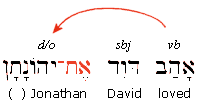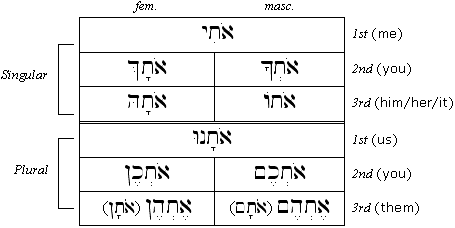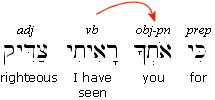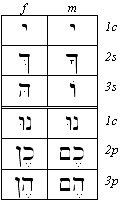|
Hebrew Object Pronouns
Introduction
As you learned in Unit 6.2, a personal pronoun can function as the subject of a clause. When a personal pronoun functions this way, we call it a "subject pronoun." For example, in the sentence "He is a great king," the pronoun he functions as the subject of the sentence.
In this unit, you will learn how the personal pronoun can function as the direct object of a verb or phrase. When a personal pronoun functions this way, we call it an "object pronoun." For example, in the sentence "Moses saw him," the pronoun him functions as the object of the verb "saw."
Nouns as Direct Objects
Of course, as you have learned in Unit 4, a noun can also function as a direct object of a verb. For example:

In the example above, the verb is built (to determine the subject of the verb, ask "Who/what built?" Answer: the king) and the direct object is great temple (to find the direct object, ask "The king built what?" Answer: a great temple). Note that the adjective gadol modifies the direct object. We would translate this sentence as "The king built a great temple."
Definite Direct Objects
As you already have studied in Unit 4.6, a noun is made definite by adding the Hey prefix. When a definite noun is the direct object of a verb, the "sign of the direct object" (or the definite direct object marker) appears before it:

For example:

In this example, the direct object is the definite noun "the temple" (haheichal) and is therefore preceded by the definite direct object marker (et). Note that this word is left untranslated. Et is used to designate that the following word is the definite direct object of the verb. We translate: "The king built the great temple."

Notice that in this sentence (from Genesis 1:1) there are two direct objects as indicated by two occurrence of the Et marker. Notice that the second definite direct object marker is prefixed with the Conjunctive Vav. God created what? The heavens and the earth.
As mentioned in Unit 4.6, proper nouns are considered definite (we say "David" and not "the David"). When a proper noun is a direct object of a verb, you will also see the Et definite direct object marker:

Notice that in this example the definite direct object marker appears (in the contruct form, using a segol with maqqef) before the name (proper noun) Yehonatan. We would translate: David loved Jonathan.
Just remember that when you see the definite direct object marker, the word that follows it is the direct object of the verb in the clause.
Objective Personal Pronouns
When a personal pronoun is used objectively as the object of a verb, the definite direct object marker (Et) is used but endings are added to indicate the gender, person, and number of the reference.
Object Pronoun Paradigm
The following paradigm lists the forms of the personal pronoun when functioning as the object of a verb:

Examples:

In this sentence (from 1 Sam 15:1) the verb is shalach (sent) and the subject is Adonai. We translate: The LORD sent me.

In this sentence (from Gen 7:1) the verb is ra'iti (meaning "I have seen") and the object of the verb is otekha, "you" (masculine singular). We translate: I have seen you righteous.

In the example above (from Gen 1:27) notice again how the pronouns function as the direct object of the verb bara (meaning "he created"). We would translate this as: "In the image of God He created him, male and female He created them."
Declensional Endings
The following endings are used with the direct object marker (et) to create the forms of the objective personal pronoun:

You should memorize these endings right away, since they are also used with nouns, adjectives, prepositions, and even verbs to indicate gender, number and person.
Section Exercises
- Memorize the section vocabulary (top of the page).
- Make sure you understand what a direct object is and how you can identify one in an English sentence. Provide some simple examples.
- Be sure you understand the function of the Hebrew definite direct object marker (et). You might want to create a flash card indicating its use with definite nouns and proper nouns. Use your Hebrew Bible to find some examples.
- Understand that an object pronoun uses the definite direct object marker (et) with endings to indicate person, gender, and number.
- Memorize the Object Pronoun Paradigm and practice reciting it in order. Create a flash card with the paradigm.
- Memorize the (pronominal) endings used for the object pronoun (apart from the declension itself). You will see these again!
<< Return
|












